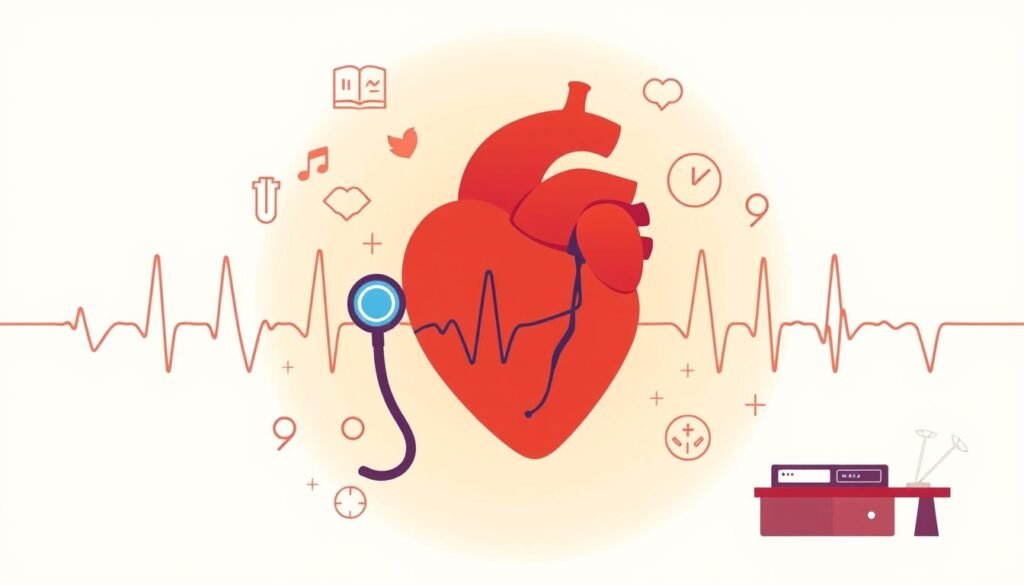Is coronary artery disease a disability? Many people ponder this question. For those affected by this widespread heart condition, the implications on both health and finances can be challenging. If it is deemed a disability, what legal rights and benefits may be available?
Our guide will explore the complex world of coronary artery disease. We’ll look at how it impacts your life, work, and disability claims. It’s time to understand the full scope of this heart condition.

Table of Contents
Key Takeaways
- Explore the legal classification of coronary artery disease as a disability
- Understand the impact of this heart condition on daily activities and work performance
- Discover the eligibility criteria and documentation required for disability benefits
- Learn about workplace accommodations and protections for individuals with heart disease
- Gain insights into the long-term management of coronary artery disease and disability claims
Understanding Coronary Artery Disease and Its Impact on Daily Life
Coronary artery disease is a major cause of heart problems. It affects the arteries that carry blood to the heart. This can lead to symptoms that make daily life hard.
Common Symptoms and Limitations
People with coronary artery disease might feel chest pain, shortness of breath, and get tired easily. These symptoms can make simple tasks like climbing stairs or carrying groceries hard.
Effects on Work Performance
The symptoms of heart condition disability can also affect work. Chest pain or shortness of breath can make it hard to focus. Taking breaks often can lower productivity and job happiness.
Impact on Quality of Life
Coronary artery disease can also affect how happy and fulfilled you feel. The fear of heart problems, managing symptoms, and the costs can cause stress and depression. This can make everyday life even harder.
It’s important to understand how cardiovascular disability affects people. This knowledge helps find ways to manage and cope with the challenges of coronary artery disease.
Is Coronary Artery Disease a Disability – Legal Definition and Criteria
Understanding if coronary artery disease is a disability involves looking at legal definitions and criteria. These are set by organizations and government agencies. Knowing this can help those seeking disability benefits, workplace changes, and legal rights.
The Americans with Disabilities Act (ADA) defines a disability as a physical or mental issue that limits major life activities. Coronary artery disease, if it severely affects someone’s job or daily life, might be seen as a disability under the ADA.
The Social Security Administration (SSA) also considers coronary artery disease a potentially disabling condition. To get SSDI or SSI, a person must show their heart disease greatly reduces their ability to work.
When deciding if coronary artery disease is a disability, several things are considered. These include how severe the disease is, the person’s symptoms, and how it affects their daily and work life. Medical records are also important to support the claim. Each case is judged based on the individual’s specific situation.
It’s important for people with coronary artery disease to know their rights and the legal criteria. They should also understand the resources available. This ensures they get the right help and benefits they deserve.
Qualifying for Disability Benefits with Heart Disease
Understanding disability benefits for heart disease can be tough. But knowing what you need can help. It makes the process easier.
Social Security Disability Insurance (SSDI) Requirements
To get SSDI, you need to meet the SSA’s rules. Your heart disease must make it hard to work and earn money. The SSA looks at how bad your condition is, how it affects your daily life, and your work history.
Medical Documentation Needed
- Detailed medical records, including diagnoses, treatment plans, and outcomes
- Test results, such as electrocardiograms (ECGs), stress tests, and cardiac catheterizations
- Documentation of any hospitalizations, procedures, or complications related to the heart condition
- Statements from the treating physician regarding the severity and limitations caused by the heart disease
Residual Functional Capacity Assessment
The RFC assessment is key in the disability process. It shows how much your heart disease limits your work abilities. The SSA looks at your stamina, physical limits, and how you handle job stress.
| Criteria | Requirement |
|---|---|
| Ejection Fraction | Less than 30% |
| Exercise Capacity | Less than 5 METs |
| Symptoms | Chest pain, shortness of breath, fatigue, dizziness |
Knowing SSDI rules, getting all your medical records, and being ready for the RFC can help. It can increase your chances of getting the disability benefits you need. This way, you can manage your heart disease and keep a good quality of life.
Medical Evidence Required for Coronary Artery Disease Disability Claims
People with coronary artery disease or heart conditions need to show proof of their illness to get disability benefits. This proof is key to show how serious the condition is. It also shows how it affects their work and daily life.
The main medical proof needed for these claims includes:
- Detailed medical records detailing the diagnosis, treatment, and progression of the coronary artery disease
- Results from diagnostic tests, such as electrocardiograms (ECGs), stress tests, and cardiac imaging studies
- Statements from the treating physician outlining the claimant’s functional limitations, prognosis, and inability to engage in substantial gainful activity
- Documentation of any hospitalizations, surgeries, or other interventions related to the heart condition
- Evidence of the impact of the condition on the claimant’s daily life and ability to work

Having a strong case with detailed medical proof is crucial for a successful claim. The evidence should clearly show how severe the condition is. It should also show how it affects the person’s health and daily life.
| Medical Evidence | Description |
|---|---|
| Diagnostic Tests | Electrocardiograms (ECGs), stress tests, cardiac imaging studies (e.g., echocardiograms, cardiac catheterization, CT scans) |
| Treatment Records | Documentation of medications, hospitalizations, surgeries, or other interventions for the coronary artery disease |
| Physician Statements | Detailed reports from the treating physician outlining the claimant’s functional limitations, prognosis, and inability to work |
| Impact on Daily Life | Evidence demonstrating the condition’s effects on the claimant’s ability to perform daily activities and work-related tasks |
By gathering all the necessary medical evidence, people with coronary artery disease can build a strong case. This increases their chances of getting disability benefits.

Workplace Accommodations for Individuals with Heart Conditions
Working with coronary artery disease can be tough. It’s a condition where plaque builds up in the arteries. But, employers must offer reasonable accommodations. This helps employees with angina or chest pain to stay productive.
Reasonable Accommodation Examples
Here are some common workplace changes for heart condition employees:
- Flexible work schedules for medical visits or breaks
- Changes to the workspace, like ergonomic chairs or standing desks, to ease strain
- Options to work from home when needed
- Switching to a job that’s less physically demanding
- Help with tasks or setting priorities to manage work
Employee Rights and Protections
People with angina disability or chest pain disability have strong protections. The Americans with Disabilities Act (ADA) and the Family and Medical Leave Act (FMLA) are there to help. These laws stop discrimination and ensure support for those with medical conditions.
“Employers have a duty to provide reasonable accommodations that enable employees with disabilities to perform the essential functions of their jobs.”
Knowing their rights and working with employers can help heart disease patients succeed at work. It also helps them stay healthy overall.
The Social Security Blue Book Listing for Cardiovascular Conditions
Understanding the Social Security Administration’s (SSA) Blue Book is key for those with heart disease seeking disability benefits. The Blue Book outlines the SSA’s criteria for evaluating medical conditions, including cardiovascular disabilities.
For those with heart disease disability, the Blue Book’s cardiovascular conditions listing is vital. It explains the medical evidence and functional limitations needed to qualify for benefits. These benefits include Social Security Disability Insurance (SSDI) or Supplemental Security Income (SSI).
| Cardiovascular Condition | Blue Book Listing | Key Criteria |
|---|---|---|
| Chronic Heart Failure | 4.02 |
|
| Ischemic Heart Disease | 4.04 |
|
| Recurrent Arrhythmias | 4.05 |
|
Knowing the Blue Book’s criteria can help those with cardiovascular disability prepare their claims better. By matching their medical evidence and functional limitations to the SSA’s needs, applicants can boost their chances of approval. This can lead to the benefits needed to support their heart disease journey.
Living with Coronary Artery Disease: Managing Work and Disability
Living with coronary artery disease can be tough. But, with the right steps, people can manage their condition and keep working or switch to disability. It’s all about making lifestyle changes and adjusting careers wisely.
Lifestyle Modifications
For those with coronary artery disease, a heart-healthy lifestyle is key. This means:
- Doing regular physical activity, like brisk walking, to boost heart health and lower risks.
- Eating a balanced diet full of fruits, veggies, whole grains, and lean proteins for overall health.
- Using stress-reducing activities, like meditation or yoga, to ease heart strain.
- Stopping smoking and drinking less alcohol, as these can worsen heart problems.
Career Adjustments
Those with is coronary artery disease a disability might need to change their work setup or tasks. Good strategies include:
- Looking into flexible work options, like remote jobs or shorter hours, to ease physical stress and manage heart condition disability.
- Talking to employers about making work easier, like adjusting the workspace or tasks, to keep working well.
- Thinking about moving to a job that’s less hard on the body or considering is coronary artery disease a disability if it really hampers work.
By taking these steps, people with coronary artery disease can find a good balance between health and work. This improves their overall life quality.
Long-term Disability Insurance and Heart Disease Coverage
Understanding long-term disability insurance can be tough, especially for those with heart disease or recovering from a heart attack. But knowing what’s out there can offer financial security and peace of mind.
These policies usually cover a part of your income, from 50% to 80%, if you can’t work due to illness. For heart disease, this support is crucial for managing both physical and financial challenges.
Key Considerations for Heart Disease Coverage
- Pre-existing Condition Exclusions: Many policies exclude pre-existing conditions. It’s key to check policy details and understand any limits or waiting periods.
- Definitions of Disability: Policies differ in what they consider a disability. Knowing the criteria for benefits is essential.
- Waiting Periods: Policies often have a waiting period, usually 90 to 180 days, before benefits start. This is something to think about when planning for disability.
By grasping the details of long-term disability insurance and its link to heart disease, people can make smart choices. This ensures they have the right coverage to protect themselves and their families if they become disabled.
| Coverage Type | Potential Benefits | Considerations |
|---|---|---|
| Group Long-Term Disability Insurance | – Typically more affordable than individual policies – Covers a percentage of your income if you’re unable to work | – May have pre-existing condition exclusions – Benefits can be limited or reduced |
| Individual Long-Term Disability Insurance | – Tailored to your specific needs – Potentially higher coverage limits – Portable (can be taken with you if you change jobs) | – Higher premiums compared to group plans – Underwriting process to qualify for coverage |
By carefully looking at their options and understanding long-term disability insurance, people with heart attack disability or coronary artery disease disability can get the coverage they need. This protects their financial well-being if they become disabled.

Filing a Successful Disability Claim for Coronary Artery Disease
Filing a disability claim for coronary artery disease can seem tough. But, with the right steps, you can boost your chances of success. We’ll look at the main steps and why claims get denied. This will help you get the benefits you need.
Application Process Steps
- Gather all necessary medical documentation: This includes detailed records of your angina disability or chest pain disability, treatment history, and the impact on your daily functioning.
- Determine your eligibility: Review the Social Security Administration’s (SSA) criteria for cardiovascular conditions to ensure you meet the requirements.
- Complete the disability application: Provide a thorough and accurate account of your symptoms, limitations, and how they affect your ability to work.
- Obtain supporting statements: Ask your healthcare providers to submit detailed statements outlining your diagnosis, prognosis, and the severity of your condition.
- Submit your claim: Be sure to follow all instructions and deadlines to ensure a timely review of your application.
Common Reasons for Denial
- Insufficient medical evidence: The SSA may deny your claim if they do not have enough documentation to support the severity of your angina disability or chest pain disability.
- Lack of functional limitations: If the SSA determines that your condition does not significantly impair your ability to perform work-related activities, your claim may be denied.
- Failure to follow prescribed treatment: The SSA expects claimants to adhere to their healthcare provider’s recommended treatment plan. Noncompliance can lead to a denial.
- Insufficient residual functional capacity: The SSA will assess your ability to perform work-related tasks despite your limitations. If they determine you can still engage in substantial gainful activity, your claim may be denied.
To win a disability claim for coronary artery disease, you need solid documentation and to follow the application steps carefully. Show clearly how your condition affects your daily life and work. With determination and the right strategy, you can succeed in getting the benefits you need.
| Successful Disability Claim Factors | Common Reasons for Denial |
|---|---|
| Comprehensive medical records | Insufficient medical evidence |
| Detailed account of functional limitations | Lack of functional limitations |
| Adherence to treatment plan | Failure to follow prescribed treatment |
| Demonstration of inability to engage in substantial gainful activity | Insufficient residual functional capacity |
Alternative Work Options and Vocational Rehabilitation
Living with heart disease disability or cardiovascular disability makes it hard to keep a job. But, there are ways to find work that fits your health needs. There are programs and options to help you find a career that works for you.
One way is to change your job to fit your health better. This could mean working different hours, doing less physical work, or using special tools to help you do your job. The law says employers must make these changes to help you do your job well.
Vocational rehabilitation services are also a big help. They offer tests, advice, and training to find the right job for you. They also help you get a job and support you as you start your new career.
| Alternative Work Options | Vocational Rehabilitation Services |
|---|---|
|
|
Exploring these options and using vocational rehabilitation can lead to a fulfilling job. It’s a job that fits your health and lifestyle needs.

“With the right accommodations and support, individuals with heart conditions can thrive in the workplace and maintain a high quality of life.”
Conclusion
Understanding coronary artery disease as a potential disability is key. It affects daily life, work, and quality of life. Recognizing its impact is crucial.
People with coronary artery disease might get disability benefits. But, getting these benefits is hard. It needs detailed records and following the Social Security Administration’s rules. Employers must also help by making work places supportive.
The journey ahead requires knowing your rights and options. Staying informed and proactive helps manage the disease. It also keeps careers going and gets the support needed to succeed.
FAQ
Is coronary artery disease considered a disability?
Coronary artery disease might be seen as a disability, depending on its severity. It affects how well someone can work. Laws and criteria for disability claims often include heart conditions like this one.
What are the symptoms and limitations associated with coronary artery disease?
People with coronary artery disease might feel chest pain, shortness of breath, and get tired easily. These symptoms can make it hard to do daily tasks and work.
What are the legal requirements for qualifying coronary artery disease as a disability?
To be considered a disability, coronary artery disease must meet certain legal standards. This includes the Americans with Disabilities Act (ADA) and the Social Security Administration’s (SSA) rules. The condition must limit major life activities, like working.
How can individuals with coronary artery disease qualify for disability benefits?
To get disability benefits, like Social Security Disability Insurance (SSDI), you need to meet SSA’s criteria. You’ll need to show your condition’s severity with medical records and pass a functional capacity test.
What type of medical evidence is required to support a disability claim for coronary artery disease?
You’ll need strong medical proof for a disability claim. This includes test results, treatment records, and statements from doctors. They should explain how your condition affects your work ability.
What workplace accommodations are available for individuals with heart conditions?
Employers must make reasonable changes for workers with disabilities, including heart conditions. This could mean adjusting schedules, using assistive devices, or changing job tasks to fit your needs.
How can individuals with coronary artery disease manage their condition while working or transitioning to disability?
Managing coronary artery disease involves lifestyle changes and career adjustments. This might include diet, exercise, stress management, and finding less demanding jobs. Working with your healthcare team and using available resources can help.
What are the key considerations for individuals with coronary artery disease seeking long-term disability insurance coverage?
Long-term disability insurance often covers heart conditions like coronary artery disease. But, the details and eligibility can vary. It’s important to understand your policy, the claims process, and what medical proof you’ll need.
What are the common reasons for denial of a disability claim for coronary artery disease?
Claims for coronary artery disease might be denied for several reasons. This includes not having enough medical evidence, not meeting disability criteria, or not showing how the condition affects work. Knowing these reasons can help you prepare your claim better.
What alternative work options and vocational rehabilitation programs are available for individuals with coronary artery disease?
People with coronary artery disease can look into different work options, like remote jobs or part-time work. Vocational programs can also help find jobs that fit your abilities and provide training to keep or find a job.



